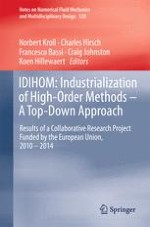The book describes the main findings of the EU-funded project IDIHOM (Industrialization of High-Order Methods – A Top-Down Approach). The goal of this project was the improvement, utilization and demonstration of innovative higher-order simulation capabilities for large-scale aerodynamic application challenges in the aircraft industry. The IDIHOM consortium consisted of 21 organizations, including aircraft manufacturers, software vendors, as well as the major European research establishments and several universities, all of them with proven expertise in the field of computational fluid dynamics. After a general introduction to the project, the book reports on new approaches for curved boundary-grid generation, high-order solution methods and visualization techniques. It summarizes the achievements, weaknesses and perspectives of the new simulation capabilities developed by the project partners for various industrial applications, and includes internal- and external-aerodynamic as well as multidisciplinary test cases.
